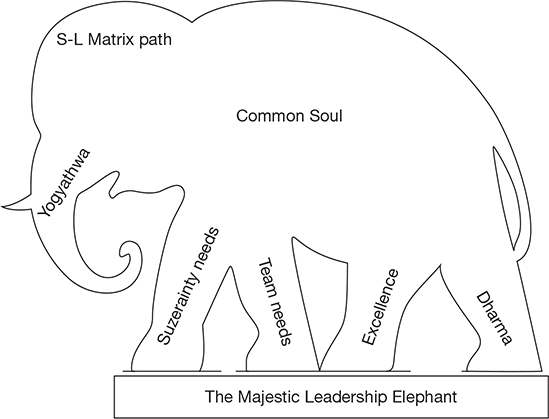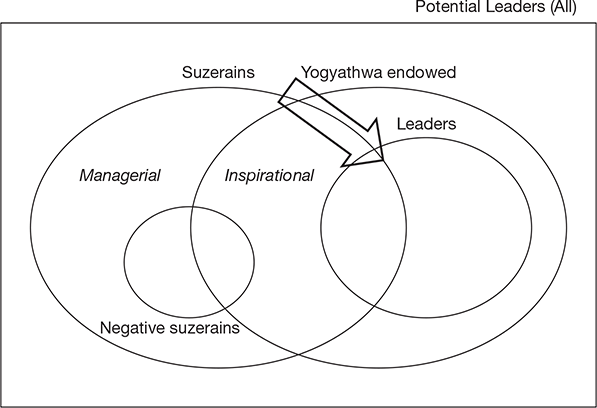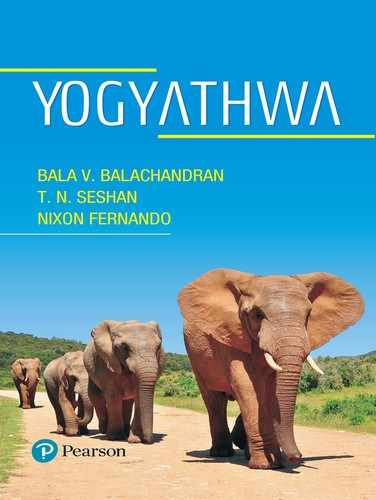CHAPTER 22
The Journey of the Complete Leader
CHAPTER OBJECTIVES
After studying this chapter, you should be able to:
- Take a summary view of the majestic leadership elephant (MLE).
- Analyze strengths and weaknesses using the seven aspects of the MLE and work out plans for self development.
The Majestic Leadership Elephant
Let us summarize the important arguments in the book through our magnificent leadership elephant.

Common Soul
We have seen that the Common Soul is the central factor in our analysis. It is because of the existence of such a ‘formless’ powerful connecting medium that leadership is able to affect all humans. The supreme-self animates each one of us … . When a man leaves behind his individuality and attains the ‘supreme self’ then he discovers that he is the ‘same as everyone else’. A person who is thus tuned to his ‘highest nature’ becomes the voice of one and all … His voice holds authority because his voice resonates with the supreme self that holds sway in every other individual as well … .
The Common Soul is the primary foundation, the body and heart of the elephant be stationed in its bosom.
The voice of the supreme self resonates in all individuals. Leadership is all about amplifying that resonance and facilitating it into action.
What are the qualities that manifest in such a person … ? Great compassion … , universal love, detachment amidst plenty, living by the moment, high levels of creativity, boundless energy, great sensitivity … So the wise say … Are not all these traits present in suzerains who have won the admiration of the world … ?
Yogyathwa
The importance of Yogyathwa in leadership arises from the fact that it helps individuals connect with the Common Soul, it helps in overcoming ego and in transcending individuality, it helps individuals read what the Common Soul wants and therefore leaders can empathize with fellowmen.
Even with the failure to understand the hypothesis that governs leadership, leadership is still possible through ‘Yogyathwa’. Taking to yoga, it is possible for individuals to be in tune with their ‘highest natures’. Such abilities can develop accidently as people grow up or they can be inculcated through the influence of the right kind of teachers.
The trunk, signifying the way we interact with the world must represent a yogic attitude. Reach out into the world through Yogyathwa.
There is also an induction effect possible in Yogyathwa; a leader can instill Yogyathwa in his followers—mostly by example. This is possible because it relates to the supreme self that is present in everyone. When induction effect happens, it brings out the best in everyone and team excellence is the result.
Therefore a leader is one who has Yogyathwa and instills Yogyathwa in his followers.
Suzerain and Team Needs
We also looked at the suzerain and his role in teams. There is a technical dimension to it and one needs to have the relevant knowledge and skills to operate as an effective member of an organization.
The forelimbs signifying technical competence for Suzerainty roles.
Excellence
Then we saw that in order for people to do the work of a suzerain effectively, in order that organizations may succeed in doing what they intended to do—with greatest efficiency—excellence is the key. Excellence can transform any environment in an organization. It can put the organization on a positive spiral. It is good for both the members of the organization and for the goals of the organization.
Dharma
We finally saw how the language of dharma deals with excellence and by using dharma and Yogyathwa prosperity and contentment can be ushered into the lives of people.
Excellence and Dharma the power houses that enable everything a leader does or inspires. These are the hind legs.
When the supreme self finds expression amongst a group of individuals and they thereby design systems for their co-existence, then it is said that dharma is established. Within such systems individuals uphold dharma by carrying out designated tasks in it. Therefore, dharma for an individual gets defined as the complete set of actions he undertakes as instructed (obliged) by the supreme self’. The supreme self’ being the moving force in him, impels him from within.
Those who are not aware of this underlying force resolve to live their lives in the pursuit of Kama and Artha. The leader inspires such as these to take to dharma and therefore makes them work at excellence—free of misery. Through this he facilitates the journey of the followers towards moksha (Selfrealization) or in other words he eggs them on towards the highest that man can get on earth.
Therefore a leader helps his fellowmen rise above Kama and Artha, instills dharma in them and leads them to moksha.
The Suzerainty-Leadership Matrix
We have also seen how the various terms associated with suzerainty and leadership can be put into a matrix. We also saw how the tendencies of actual personalities can be identified as regions and arrows on this chart.
The thought in the brain of the elephant is to be aware of the leadership map so as to be driven to that which is higher.
The Journey of a Leader
When the question of the reader/student’s journey on the path of leadership arises then the S-L matrix indicates how best it can be done. The best way is of course to have a bearing that indicates a region within the leader ellipse (refer to the following diagram). That would indicate a person who is constant in connection with the Common Soul and is aware about the graces of leadership. But, when we are not there yet then what must one do?
One must follow towards that ellipse and as far as possible increase one’s presence inside the leadership ellipse as much as possible.
This can be indicated in the matrix as an arrow as follows …
A leader must journey deeper into Yogyathwa till he finds a home in leadership.

In order to move in such direction one must focus on the majestic leadership elephant. Leaders must endeavor to find oneness with the Common Soul, deal with the world through Yogyathwa and strengthen the four pillars: knowledge of suzerainty, responsibility for team needs, excellence (awareness of its need and effect) and upholding dharma. By doing all this it would indicate that the mind of the majestic leadership elephant is well directed and is set to pay dividends to the individual and the people around him. This then completes our majestic leadership elephant.
Referring back to the table in Chapter 3, we have the following:
| 1 | Be | Common Soul |
| 2 | Practice | Yogyathwa |
| 3 | Attain self sufficiency in | Suzerainty Needs |
| 4 | Take responsibility for | Team Needs |
| 5 | Focus and facilitate | Excellence |
| 6 | Uphold | Dharma |
| 7 | Wisely choose | Suzerainty-Leadership Matrix Path |
A Prayer from the Authors
The authors wish for the reader/student to take a journey on that suzerainty-leadership matrix path which leads towards the innermost ellipse … One who walks that path will be a blessing unto himself and unto all those who look up to him … .
Exercises
- Analysis: Select any leader and evaluate his performance on the seven aspects of the Suzeranity leadership matrix. (250 words for each aspect)
- Analysis: Do a swot analysis using the seven aspects. Consider your readiness for a role in a given organization and where you can develop so as to be effective as a suzerain in it.
